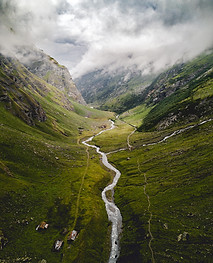
frameworks
There are so many ways in which we can improve our way of living to positively impact the world around us, or at least limit the harmful affects our existence can effect.
Planetary Boundaries
There Are 9 Planetary Boundaries

Stratospheric Ozone Depletion
The stratospheric ozone layer in the atmosphere filters out ultraviolet (UV) radiation from the sun. If this layer decreases, increasing amounts of UV radiation will reach ground level.
This can cause a higher incidence of skin cancer in humans as well as damage to terrestrial and marine biological systems.

Climate Change
Recent evidence suggests that the Earth, now passing 390 ppmv CO2 in the atmosphere, has already transgressed the planetary boundary and is approaching several Earth system thresholds.
We have reached a point at which the loss of summer polar sea-ice is almost certainly irreversible.

Land System Change
Land is converted to human use all over the planet. Forests, grasslands, wetlands and other vegetation types have primarily been converted to agricultural land.
This land-use change is one driving force behind the serious reductions in biodiversity, and it has impacts on water flows and on the biogeochemical cycling of carbon, nitrogen and phosphorus and other important elements.

Loss of Biosphere Integrity Biodiversity Loss & Extinctions
The main drivers of change are the demand for food, water, and natural resources, causing severe biodiversity loss and leading to changes in ecosystem services.

Ocean Acidification
Around a quarter of the CO2 that humanity emits into the atmosphere is ultimately dissolved in the oceans. Here it forms carbonic acid, altering ocean chemistry and decreasing the pH of the surface water. This increased acidity reduces the amount of available carbonate ions, an essential 'building block' used by many marine species for shell and skeleton formation.

Nitrogen and Phosphorus Flows to the Biosphere and Oceans
The freshwater cycle is strongly affected by climate change and its boundary is closely linked to the climate boundary, yet human pressure is now the dominant driving force determining the functioning and distribution of global freshwater systems.
The biogeochemical cycles of nitrogen and phosphorus have been radically changed by humans as a result of many industrial and agricultural processes.
Nitrogen and phosphorus are both essential elements for plant growth, so fertiliser production and application is the main concern. Human activities now convert more atmospheric nitrogen into reactive forms than all of the Earth's terrestrial processes combined.

Chemical Pollution and the Release of Novel Entities
Emissions of toxic and long-lived substances such as synthetic organic pollutants, heavy metal compounds and radioactive materials represent some of the key human-driven changes to the planetary environment.
These compounds can have potentially irreversible effects on living organisms and on the physical environment (by affecting atmospheric processes and climate)

Freshwater Consumption and the Global Hydrological Cycle
The freshwater cycle is strongly affected by climate change and its boundary is closely linked to the climate boundary, yet human pressure is now the dominant driving force determining the functioning and distribution of global freshwater systems.
The consequences of human modification of water bodies include both global-scale river flow changes and shifts in vapour flows arising from land use change.

Atmospheric Aerosol Loading
An atmospheric aerosol planetary boundary was proposed primarily because of the influence of aerosols on Earth's climate system.
Through their interaction with water vapour, aerosols play a critically important role in the hydrological cycle affecting cloud formation and global-scale and regional patterns of atmospheric circulation, such as the monsoon systems in tropical regions.
Johan Rockstrom
Stockholm Resilience Centre
Resilience Centre (SRC) is an international research centre on resilience and sustainability science
UNited nations Sustainable Development Goals
No Poverty
End poverty, in all its forms, everywhere.
Quality Education
Ensure inclusive and equitable quality education and promote lifelong learning opportunities for all
Affordable & Clean Energy
Ensure availability and sustainable management of water and sanitation for all
Industry, Innovation, Infrastructure
Build resilient infrastructure, promote inclusive and sustainable industrialisation and foster innovation
Responsible Consumption & Production
Ensure sustainable consumption and production patterns
Peace, Justice & Strong Institutions
Promote peaceful and inclusive societies for sustainable development, provide access to justice for all and build effective, accountable and inclusive institutions at all levels
Zero Hunger
End hunger, achieve food security and improved nutrition and promote sustainable agriculture
Gender Equality
Achieve gender equality and empower all women and girls
Decent Work & Economic Growth
Ensure availability and sustainable management of water and sanitation for all
Reduced Inequalities
Reduce inequality within and among countries
Climate Action
Take urgent action to combat climate change and its impacts
Partnerships for the Goals
Strengthen the means of implementation and revitalise the global partnership for sustainable development
Good Health & Wellbeing
Ensure healthy lives and promote well-being for all at all ages
Clean Water & Sanitation
Ensure availability and sustainable management of water and sanitation for all
Clean Water & Sanitation
Promote sustained, inclusive and sustainable economic growth, full and productive employment and decent work for all
Sustainable Cities & Communities
Make cities and human settlements inclusive, safe, resilient and sustainable
Life Below Water
Conserve and sustainably use the oceans, seas and marine resources for sustainable development
Doughnut Economics
A visual framework for living sustainably. First published in 2012 in an Oxfam report by Kate Raworth.
Doughnut Economics combines the concept of planetary boundaries with the complementary concept of social boundaries.
Kate Raworth's
Seven Ways to Think Like a 21st Century Economist.
Between social and planetary boundaries lies an environmentally safe and socially just space in which humanity can thrive. Doughnut Economics explores the mindset and ways of thinking needed to get us there.








